duets: flute and piano
-
Haydn - Adagio, Quartet Op.20, No.5 - Fl & Pf
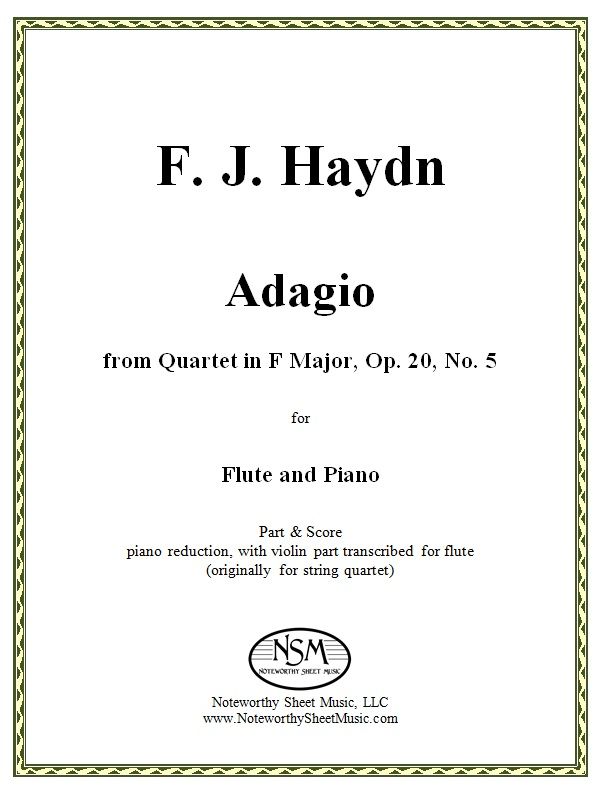 Adagio from Quartet in F Major, Op.20, No.5, by F. J. Haydn
Adagio from Quartet in F Major, Op.20, No.5, by F. J. HaydnArranged for Flute and Piano by John W. Pratt
Flute Part and Piano Score, PDF $10.00
The third movement of Haydn's string quartet Opus 20, No. 5 is an Adagio with a simple melody that is treated to delightful filigreed elaboration and obbligato decoration by the violin. Although more complex quartet movements are typically unsuited to transcription, in this beautiful Adagio the soloistic nature of the violin part and the simplicity of the lower string parts lend themselves very well to an arrangement for flute and piano, as in the fine transcription we offer here.
Flute part, 3 pages of music; Piano score, 7 pages of music; Total, 14 pages.
Preview -
Mendelssohn - Concert Piece No.2 - Two Winds (and Piano)
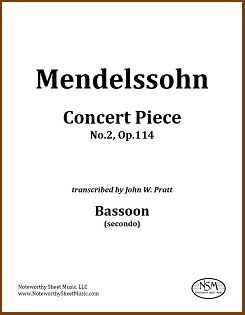 Concert Piece No.2, Op.114, by Felix Mendelssohn
Concert Piece No.2, Op.114, by Felix MendelssohnTranscribed for Various Wind Instruments (and piano) by John W. Pratt
(originally for Clarinet, Basset Horn, and Piano)
Primo parts for Clarinet, Flute, or Oboe, PDFs $5.99 each
Secondo parts for Bassoon, Clarinet, or English Horn, PDFs $5.99 each
The following is excerpted from John Pratt's © foreword:
In 1833, Felix Mendelssohn (1809-1847) wrote two Concert Pieces for Clarinet, Basset Horn, and Piano, op. 113 and op. 114, as show-pieces for the famous clarinetist Heinrich Bärmann (1784-1847) to play with his up-and-coming son Karl (1811-1885) on the basset horn. // These works are very suitable for transcription, even aside from the rarity of the basset horn today. We provide, as well as the original clarinet part, transcriptions of it for flute and oboe. Transcriptions of the basset horn part are provided for bassoon, clarinet, and English horn. These primo and secondo parts can be mixed and matched at will. // Since a good quality PDF of the original piano score with excellent page turns is freely available in the public domain (see IMSLP.org), we have not provided a score here; our transcribed primo and secondo wind parts can readily be used with the original score.
Each wind part is 4 pages of music; 6 pages total.
Primo parts for Flute, Clarinet in B-flat (note that the original primo clarinet part is freely available on IMSLP.org), or Oboe.
Secondo parts for Clarinet in B-flat, Bassoon, or English Horn. Preview Bassoon II part
-
Sarasate - Romanza Andaluza - Flute
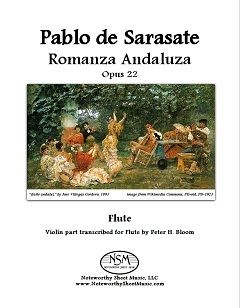 Romanza Andaluza, by Pablo de Sarasate
Romanza Andaluza, by Pablo de SarasateTranscribed for Flute (originally for violin) by Peter H. Bloom
Flute Part, PDF $6.66
'Pablo Sarasate was one of those rare violin virtuosos whose compositions, while designed to display instrumental athleticism, also expressed elegance, economy, imagination, a suave sensuality, and musical integrity. His music befits the sort of technique that, although acrobatic, is captivating rather than assaultive; evocative rather than provocative. It's with this spirit—to amuse, amaze, and engage the audience while providing a satisfying challenge to the performer—that I've adapted his Romanza Andaluza for flute.
Sarasate frequently used the musical material of folk songs and dances from his native Spain as a framework for his pieces. With the melody prescribed, the harmonies implied, and the style both familiar and exotic, he would paraphrase, embellish, and interpret as if to say "with the violin, we can do this..." Inspired by his source material, his methods, and his style, I propose that: With the flute, then, we can do this...' ― Peter H. Bloom, June 23, 2012 ©
Romanza Andaluza, Op.22 was written originally for violin and piano. Editions of the piano score (click to access) are available as free PDF downloads from online libraries of public domain music, such as imslp.org. We provide the Flute part - click below to preview p1.
Flute part, 4 pages; Total, 6 pages.
Preview -
Scriabin - Romance - Transcribed for Clarinet, Flute, or Alto Flute
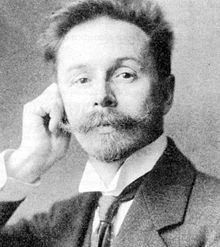 Romance, by Alexander Scriabin
Romance, by Alexander ScriabinTranscribed for Clarinet or Flute or Alto Flute (and Piano) by J. W. Pratt
Parts, PDF $0.00
Alexander Scriabin (1872-1915), the mystic Russian composer with music to match, wrote nine mind-bending orchestral works and myriad mostly miniature piano pieces. He began as a "Russian Chopin" and ended planning a week-long "Mysterium" to be performed in the Himalayas using "an orchestra, a large mixed choir, an instrument with visual effects, dancers, a procession, incense, and... mists and lights" (Wikipedia).
The Romance of 1890, his only chamber work except one variation for string quartet, is nearer the Chopin end of that spectrum, though the piano part adds harmonic and rhythmic complexities not evident from the solo part alone.
- John W. Pratt, Jan. 19, 2016
Please click on the links to download your free PDFs:
Transcription for clarinet required no changes of pitch. Scriabin - Romance - Clarinet
The transcription for flute is raised an octave, except the last five measures. Scriabin - Romance - Flute
The transcription for alto flute raises MM21-24 and MM36-48 an octave. Scriabin - Romance - Alto Flute
The piano score is freely available on IMSLP.org.
Scriabin image courtesy of Wikimedia.org, PD-old.
-
Dieter - The Golden “Reade” Flute - Flute & Piano
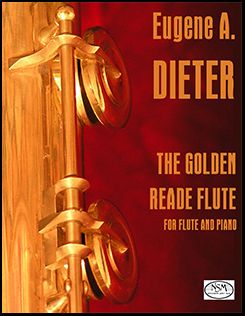 The Golden "Reade" Flute, by Eugene A. Dieter
The Golden "Reade" Flute, by Eugene A. DieterFlute Part and Piano Score ― PDF $7.99
Elmer Reade (1898-1986), to whom The Golden "Reade" Flute is dedicated, served a long and distinguished career, first as a flutist with the U.S. Army Band and then as a conductor and music director of the Air Force Band at Mitchell Field, New York. Eugene A. Dieter graduated from the first class of the US Army Music School in 1941 and was appointed a bandmaster. Following the Second World War, Dieter accepted a bandmaster position with the Air Force Band and remained active until his retirement in 1966. Likely, it was as an Air Force band colleague of Elmer Reade's that Dieter was inspired to compose The Golden "Reade" Flute. (excerpted from the foreword © by P. H. Bloom)
Not at all militaristic in character, The Golden "Reade" Flute is more a lovely barcarole, a single Andante moderato movement in 6/8 time. It offers interesting writing for both parts, so flutist and pianist will be equally pleased. The title refers to the gold flute by William S. Haynes upon which Reade regularly performed.
Piano score, 4 pages; Flute part, 2 pages.
Preview -
Bridge – 4 Short Pieces – Flute or Alto Flute (and Piano)
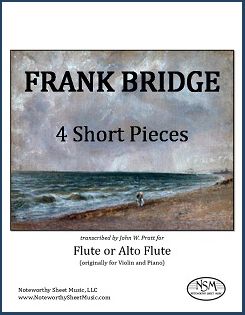 4 Short Pieces, by Frank Bridge
4 Short Pieces, by Frank BridgeTranscribed for Flute or Alto Flute (and Piano) by J.W.Pratt
Flute Part, Alto Part, PDF $8.99
The 4 Short Pieces by Frank Bridge were written for violin and piano, and first published in 1912. As noted in John Pratt's foreword to the edition, they "provide a fine and delightful introduction to an accessible post-romantic composer who should be better known." The pieces are "Meditation", "Spring Song", "Lullaby", and "Country Dance". Mr. Pratt has created transcriptions of the violin parts for both flute and alto flute, and we include both instrument versions in this edition. We think Nos. 1 and 3 sound particularly nice on the alto flute and No. 4 is a splendid romp on the C flute, but all four are effective on either instrument, so we prefer to let our flutists decide on which instrument they choose to play each piece. We provide only our flute and alto flute transcriptions; the piano score, including the original violin part, is available as a free pdf download at imslp.org.Flute part, 5 pages; Alto Flute part, 5 pages; Total, 14 pages.
Preview
-
Vercoe – Kleemation – Flute & Piano
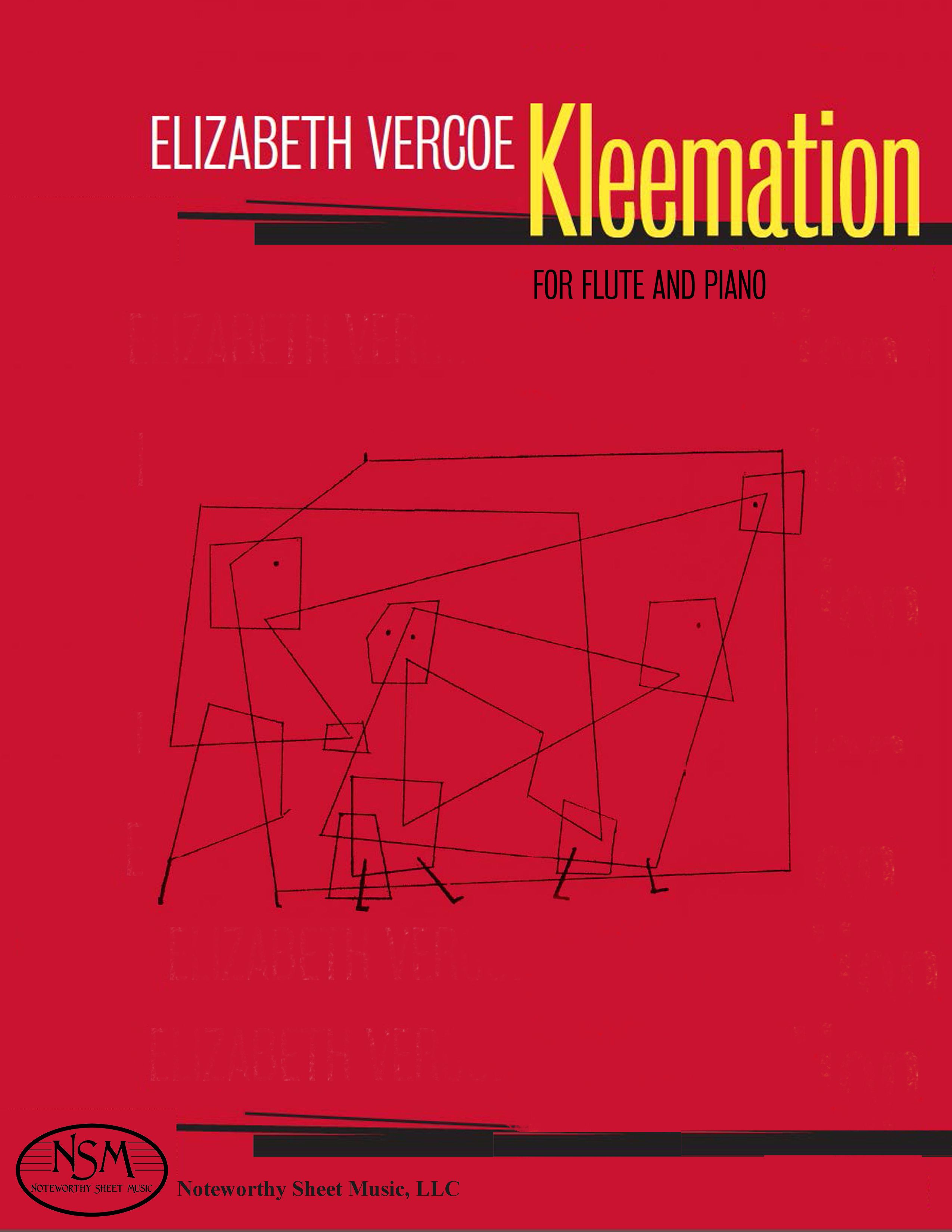 Kleemation, by Elizabeth Vercoe
Kleemation, by Elizabeth VercoeOriginal Composition for Flute and Piano
Flute Part and Piano Score, PDF $16.95
Kleemation for flute and piano is in five short movements based on five drawings by Paul Klee titled: Goodbye to You, Please!, Afraid on the Beach, More Will Be Marching Soon, and Woman Sowing Weeds. Described as "highly abstract yet accessible," the piece was commissioned by Austin Peay University in Tennessee and received its premiere there in 2003. The New England premiere was at the Duxbury Art Museum in 2004 by the duo "2" (flutist Peter H. Bloom and pianist Mary Jane Rupert). "2" has since performed the piece on tours in the U.S., Thailand, Australia, and New Zealand. Click to read a testimonial to Elizabeth Vercoe's composition Kleemation written by Mr. Bloom.
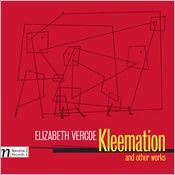
Kleemation was recorded by "2" and can be heard on the PARMA Recordings all-Vercoe CD entitled Kleemation and Other Works by Elizabeth Vercoe. In an IAWM Journal CD review Dr. Laura G. Kafkawrites: “Vercoe musically renders Klee’s drawings with all the humor, fear, and reality that make each one leap from its canvas and dance.” Click to read Dr. Kafka’s full review. In another review published by Audiophile Audition magazine on September 26, 2013, Lee Passarella writes: "Vercoe (b. 1941) also shows a willingness to adapt different musical styles and elements to her basic idiom: the essential atonality of her music is leavened with some well-chosen pop influences where appropriate to the subject matter at hand. That includes Kleemation, a work based on drawings by Swiss modernist painter Paul Klee. Klee's sometimes whimsical, sometimes troubling art turns for its inspiration to the uninhibited world of the child artist."
Listen to an audio sample of Kleemation
 from the opening of the title piece.
from the opening of the title piece.Piano score, 27 pages; Flute part, 11 pages; Total, 44 pages; PDF $16.95.
Preview
For those who would prefer to purchase a printed hard copy of this piece, rather than the PDF download offered here, our print edition of Kleemation for Flute and Piano by Elizabeth Vercoe is availabledirectly from NSM for $26.99 plus a $5.95 shipping and handling fee. Due to prohibitively high international shipping rates, we ship print editions only to addresses in the USA. Please use the Contact Us form to let us know which hard copy publication(s) you would like to purchase, along with your email contact information and USPS mailing address. We will then send you a PayPal invoice for the sale and, once we receive notice from PayPal that you have paid for the item(s), we will ship your music to the address provided.
-
Tchaikovsky - The Nutcracker - Flute & Piano
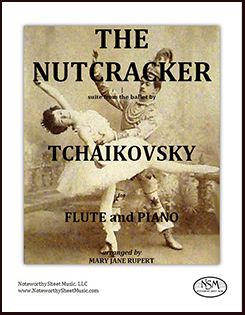 The Nutcracker, by P. Tchaikovsky
The Nutcracker, by P. TchaikovskyArranged for Flute and Piano by Mary Jane Rupert
Flute Part and Piano Score, Complete PDF $17.95 (also available as individual pieces)
Mary Jane Rupert, pianist and harpist, has performed as soloist, chamber musician, and orchestral player in many groups in the Boston area throughout the past three decades. She has toured the United States, Thailand, and New Zealand as a member of the duo "2" with flutist Peter Bloom, and performed with such other groups as the Southcoast Chamber Players, Musica Sacra, the Cecilia Society, and the Boston Philharmonic Orchestra. Educated at Oberlin College and Indiana University, Dr. Rupert earned a B.M. in piano, M.M. degrees in both harp and piano, and a doctorate in piano performance. Having taught at Western Michigan University, Oberlin College, and Wellesley College, she now maintains a private studio for both piano and harp in Cambridge, MA.

Dr. Rupert's superb arrangement of The Nutcracker for flute and piano includes all of the pieces from the original Suite Op.71a from the ballet by Tchaikovsky, except the Overture. Professionals, students, and amateur musicians should all find uses for these popular pieces—as encores, recital pieces, and as part of the repertoire for more informal musical occasions. Read a review of the arrangement by John Ranck that was published in The Flute View.
Listen to audio excerpts of
Complete Edition: Piano score, 44 pages; Flute part, 14 pages; Total, 64 pages (please print double-sided). PDF $17.95 Chinese Dance and
Chinese Dance and  Trepak performed by Peter H. Bloom and Mary Jane Rupert.
Trepak performed by Peter H. Bloom and Mary Jane Rupert.
PreviewFor anyone wishing to purchase individual pieces of Mary Jane Rupert's arrangement of The Nutcracker for flute and piano, rather than the entire suite, we also offer the seven pieces as separate PDF's. Just check the appropriate box in the Add to Cart table below:
Arab Dance: Piano score, 6 pages; Flute part, 1 page; Total, 9 pages. PDF $7.99Chinese Dance: Piano score, 4 pages; Flute part, 1 page; Total, 7 pages. PDF $5.99Dance of the Reed Flutes: Piano score, 4 pages; Flute part, 2 pages; Total, 10 pages. PDF $5.99Dance of the Sugar Plum Fairy: Piano score, 3 pages; Flute part, 1 page; Total, 7 pages. PDF $4.99March: Piano score, 4 pages; Flute part, 1 page; Total, 7 pages. PDF $5.99Trepak (Russian Dance): Piano score, 5 pages; Flute part, 2 pages; Total, 12 pages. PDF $6.99Waltz of the Flowers: Piano score, 18 pages; Flute part, 6 pages; Total, 28 pages. PDF $10.99===========================================================
We also offer a professionally-printed hard copy edition of the complete version of The Nutcracker for $33.33 plus a $5.95 shipping and handling fee to addresses in the USA. Please use the Contact Us form to let us know which hard copy publication(s) you would like to purchase, along with your email contact information and USPS mailing address. We will then send you a PayPal invoice for the sale and, once we receive notice from PayPal that you have paid for the item(s), we will ship your music to the address provided.
-
Bridge – 4 More Short Pieces – Flute or Alto Flute (and Piano)
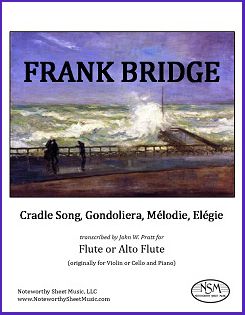 Cradle Song, Gondoliera, Mélodie, and Elégie, by Frank Bridge
Cradle Song, Gondoliera, Mélodie, and Elégie, by Frank BridgeTranscribed for Flute or Alto Flute (and Piano) by J. W. Pratt
Preview
Flute Part, Alto Part, PDF $11.99
Like the 4 Short Pieces for Violin and Pianoforte published in transcription by Noteworthy Sheet Music earlier this year, these additional four short pieces by Bridge "provide a fine and delightful introduction to an accessible post-romantic composer who should be better known." Published by Bridge between 1903 and 1911, the works included in our second edition are transcriptions of Cradle Song, written for violin or cello and piano, Gondoliera for violin and piano, and Mélodie and Elégie for cello and piano. Mr. Pratt has created transcriptions of all four pieces for both flute and alto flute, and we include both instrument versions in this combined edition. We think Cradle Song and Elégie are particularly beautiful on the alto flute, but all are effective on either instrument, so we prefer to let our flutists decide on which instrument they choose to play each piece. We provide our flute and alto flute parts only; the original piano scores work well with our transcriptions and are available, along with the violin and cello parts, as free pdf downloads at imslp.org—click the links to access the scores for Cradle Song, Gondoliera, Mélodie, and Elégie.
Flute part, 6 pages; Alto Flute part, 6 pages; Total, 14 pages. -
Coste - Les Regrets - Afl or Fl (or Ob, Vn) and Pf (or Guitar, Harp)
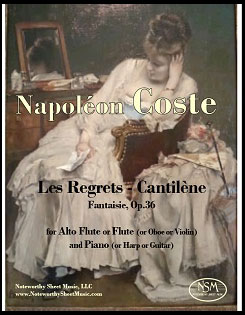 Les Regrets-Cantilène, Op.36, by Napoléon Coste
Les Regrets-Cantilène, Op.36, by Napoléon CosteTranscribed for Alto Flute or Flute (or Oboe or Violin) and Piano (or Harp or Guitar) by C.A.Vater
Score, Alto Flute Part, and alternative Flute (or Oboe or Violin) Part, PDF $5.99
Napoléon Coste (1805-1883) became famous not only as a guitar soloist, but also as a major composer of some 60 works, most of which were written for guitar. His music is in the romantic French style and appreciated for its originality. His Fantaisie, Op.36, Les Regrets-Cantilène, is a short, single-movement piece written for oboe or violin with piano or harp or guitar. We created our Noteworthy Sheet Music edition from the difficult-to-read manuscript version in the public domain, available on imslp.org. We include a score in concert pitch and a part suitable for flute, oboe or violin, as well as a part transcribed for alto flute in G. The piece falls nicely within the sweet range of the alto flute and our transposition sounds appealing and completely natural on that instrument. In fact, Les Regrets-Cantilène is gorgeous on either flute or alto flute. Melodic and sentimental, the work is not overly demanding technically and should appeal to players of a moderate or higher skill level.
Preview
Score, 4 pages; Alto Flute part, 1 page; Flute (or Oboe or Violin) part, 1 page; Total 8 pages. -
Burleigh - Southland Sketches, Nos. I, III, IV - Alto Flute or Flute (& piano)
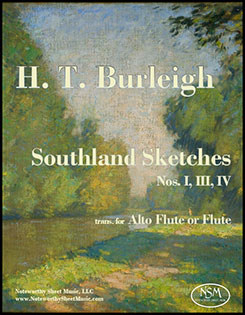 Southland Sketches, Nos. I, III, IV, by H. T. Burleigh
Southland Sketches, Nos. I, III, IV, by H. T. BurleighTranscribed for Alto Flute or Flute (and piano) by C. A. Vater
Alto Flute part and Flute part, PDF $9.96
Harry Thacker Burleigh was an acclaimed African-American singer, music editor, and composer whose adaptations of African-American spirituals became famous. His Southland Sketches, which were composed for violin and piano and published by G. Ricordi in 1916, are a fine example of Burleigh’s quintessential American style. The original composition included 4 movements. Our edition excludes the second movement, but adapts three of the original four miniatures for either alto flute or flute. We provide only the transcribed alto flute and flute parts, as they have been designed to work well with the piano part in the original score for violin and piano which is available as a good quality, free pdf download from imslp.org. Performers may choose to play all three of these pieces on either flute or alto flute, or switch instruments between sketches, depending on personal preference.
Alto Flute part, 6 pages; alternate Flute part, 6 pages; Total,18 pages. (pdf of piano accompaniment is freely available at imslp.org)
Preview
-
Schubert - Rondo in B minor - Flute (and Piano)
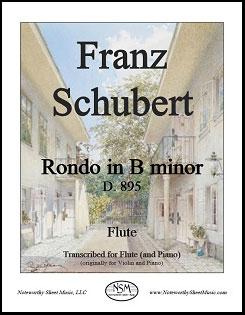 Rondo in B minor, D.895, by Franz Schubert
Rondo in B minor, D.895, by Franz SchubertTranscribed for Flute (and Piano) by J.W.Pratt and C.A.Vater
Flute Part, PDF $11.99
The Rondo in B minor, D.895 (alternatively known as Rondeau brillant) was written for violin and piano in 1826 by the great Austrian composer Franz Peter Schubert. Dedicated to the young violin virtuoso Josef Slawjk, the Rondo is demanding in both the solo and piano parts. The work consists of an Andante introduction and an Allegro rondo, and is quite long at 713 measures and typically some thirteen minutes or more in duration. Inexplicably, the piece is less familiar to players and audiences than many of Schubert’s other works. Brian Newbould, renowned composer, conductor, author, and Schubert expert, wrote of the Rondo in his treatise Schubert: The Music and the Man (University of California Press, Jan 1, 1997, p365): “Not surprisingly, perhaps, it is little known because it is seldom played. But it is also undervalued: it scintillates, dances and sings, with a blend of infectious joy, tireless energy, rhythmic zip and ‒ from time to time ‒ heart-melting turns of melody and harmony.”
These characteristics and the way the music realizes them are not only suitable to but often even suggestive of a wind instrument. Our transcription provides effective flute-friendly alternatives for the violin’s double-stops as well as for notes that fall below the flute’s range, so the piece can be played comfortably and beautifully on flute. The Rondo is virtuosic in places, showy and exciting, and overall great fun to play. The Noteworthy Sheet Music edition of our transcribed flute part does not include a re-notated copy of the score, since high-quality PDFs of the piano and violin score are freely available in the public domain and are sufficient to use along with our flute part, in lieu of violin. To download one such PDF of the score, please visit the Rondo’s page on IMSLP.Flute part, 12 pages; Total 14 pages.
Preview -
Schumann, Clara - Three Romances - Alto Flute or Flute (and Piano)
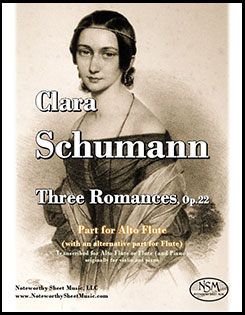 Three Romances, Op.22, by Clara Schumann
Three Romances, Op.22, by Clara SchumannTranscribed for Alto Flute or Flute (and Piano) by C.A.Vater
Alto Flute Part and alternative Flute Part, PDF $8.99
Clara Schumann’s Drei Romanzen für Pianoforte und Violine, Op. 22, were written in 1853 and dedicated to the Schumanns’ great friend, the famous Hungarian violin virtuoso Joseph Joachim, with whom Clara performed the Three Romances when they concertized together on tours across Europe. The Romances are lovely, short pieces; melodic and expressive, they epitomize the Romantic era and represent true chamber music in the sense that both instruments are featured comparably, rather than the piano having a merely accompaniment role. They are nicely adaptable to wind instruments, and are particularly lovely when played on alto flute. Our transcription required few modifications to bring the original violin part completely in range for alto flute and provide flute-friendly, musically-appropriate alternatives to the occasional violin double-stop. Some flutists may wish to mix and match the three movements, preferring to play one or two of the Romances on alto flute and the third on concert flute, or vice versa; so, to that end, we have included in this edition a complete alternative part adapted for C-flute. We do not provide a re-notated copy of the score, however, since high-quality PDFs of the piano and violin score are freely available in the public domain, and are easy to use along with our flute transcriptions of the violin line. To download one such PDF of the score, please visit the imslp website.
Alto Flute part, 5 pages; Flute part, 5 pages; Total 14 pages.
Preview -
Glazunov - Elegy - Flute or Alto Flute
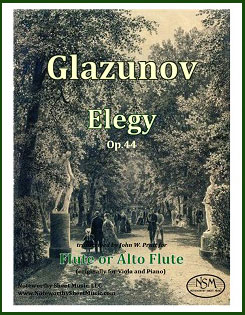 Elegy, Op.44, by Alexander Glazunov
Elegy, Op.44, by Alexander GlazunovTranscribed for Flute or Alto Flute (and Piano) by John W. Pratt
Parts for Flute and Alto Flute, PDF $5.99
Alexander Konstantinovich Glazunov (1865-1936) was a major composer in the late Russian romantic tradition. His Elegy, Op.44, was written for viola and piano in 1893. The viola melody is readily adaptable for other instruments, since it is without double stops, and has been transcribed here by John W. Pratt for either flute or alto flute. The piece is about 6 minutes long, elegiac but not lugubrious. It consists of a lovely melody in 9/8 time, enhanced by a simple but warm piano accompaniment. The NSM edition includes a flute part and an alternative alto flute part, but does not include one for piano, since a suitable score is freely available at IMSLP.org.
Flute part, 2 pages; Alto Flute part, 2 pages; Total, 8 pages.
Preview -
Popp - Greetings to Hungary - Flute and Piano
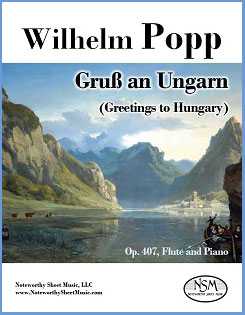 Greetings to Hungary, Op.407, by Wilhelm Popp
Greetings to Hungary, Op.407, by Wilhelm PoppFlute and Piano
Flute Part and Piano Score, PDF $0.00
Wilhelm Albrecht Otto Popp (1828-1903) was an esteemed German composer, flutist, and pianist. He received his flute training from Caspar Kummer and Louis Drouet, and served as court pianist and flutist at the Ducal Saxon Court Theater in Coburg-Gotha. In 1867 he moved to Hamburg and became first flute of the Hamburg Philharmonic Orchestra. Popp composed some 600 works, many of which were written for flute and piano; most of his compositions were published in his lifetime and were well-known to musicians of his day.
Wilhelm Popp’s Gruß an Ungarn (Greetings to Hungary) was first published for flute and orchestra in 1890, and an edition for flute and piano was published in 1899. NSM re-notated the flute and piano version, changing only the formatting and adding bar numbers and a new cover page. With a decidedly Hungarian sentiment, this piece is great fun to play and provides an enjoyable, exciting listen for audiences as well.
Click for a free download of our re-typeset edition of Popp’s Gruß an Ungarn.
Piano score, 8 pages; Flute part, 5 pages; Total 16 pages.
-
Danzi - Grande Sonate - Piano & Flute
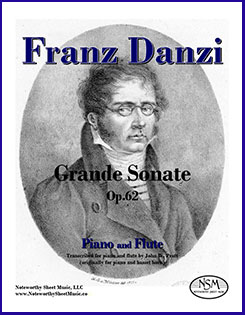 Grande Sonate, Op.62, by Franz Danzi
Grande Sonate, Op.62, by Franz Danzitranscribed for Piano and Flute by John W. Pratt
Piano score and Flute part, PDF $14.99
excerpted from John Pratt’s foreword to the edition: 'Franz Danzi (1763-1826) was an active musician, cellist, and teacher in Mannheim, Munich, Stuttgart, and Karlsruhe. A prolific composer, especially of music for the stage and chamber music from keyboard solos to sextets, he revered Mozart and mentored Weber. His wind quintets are notable. His Grande Sonate, Opus 62, for piano and basset horn, was published about 1823, along with an alternative cello part which sometimes differs from the basset horn part in other ways than octave transposition. // The sound of the basset horn varies widely, depending on its construction, who is playing, what is being played, and who is describing it. George Bernard Shaw said, ''The devil himself could not make a basset horn sparkle.'' Burnet Tuthill, in Cobbett's Cyclopedic Survey of Chamber Music (1929), wrote of its "soft mellow timbre of rich beauty.” E.T.A. Hoffmann likened its sound to the scent of red carnations (see Georgina Dobré, The Basset Horn,who says, pace Shaw, “Sparkle it certainly can!”). That tent is broad enough to cover the characteristics of both the flute and the clarinet comfortably, and Danzi’s Grande Sonate alternates sparkle and mellow rich beauty in large measure.' Since we at NSM have grown quite fond of this piece, we decided to transcribe it for both flute and clarinet, so we and our friends could enjoy playing it. We offer here the flute edition, with a version for clarinet to follow in the coming weeks.
Piano score, 28 pages; Flute part, 7 pages; Total 40 pages.
Preview -
Slawinski - Cookies - Flute & Piano
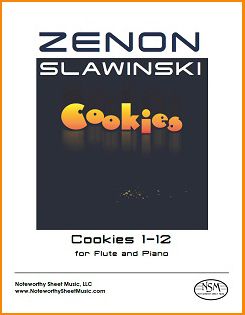 Cookies, by Zenon Slawinski
Cookies, by Zenon Slawinski Contemporary Composition for Flute and Piano
Flute Part and Piano Score, PDF $24.50
From the preface by Zenon Slawinski:
The Cookies came about because my wife and I had been exploring the various compositions and arrangements available for flute and piano and I felt that we needed something new for our time and our audience. We live in a constantly changing world yet we love to hang our hat on the past, especially when it comes to music. I wanted to create a set of pieces that would not only be enjoyable for the listener but provide the players with a high level of satisfaction.
These pieces range in difficulty from the rather simple and easy to play (Cookies 1, 2, 4, 7), to the intermediate (Cookies 5, 8, 9, 11), and to the more challenging (Cookies 3, 6, 10, 12).
A special note about Cookie No. 5. This piece was influenced by the Jazz tunes in the popular series of Real Books which follow a common practice in today's "chart" or "lead sheets" where the melody line is written out and chords are marked for the accompaniment to play. This gives a lot of freedom initially to the piano. As the flutists becomes more familiar with their part, I would encourage them to get off the page and try some of their own lines.
I purposely gave few performance markings so that players can create their own. Interpret these freely and have fun.
Zenon Slawinski, September 17, 2014
You may listen to some short audio samples of the Cookies, recorded on the composer’s Yamaha MOTIF ES with the sampled piano and flute sounds found in the instrument.
Customers who purchase the sheet music to Cookies are entitled to free rehearsal mp3’s of the piano tracks with which the flutist may play along.
Cookie 9 is a flute solo; the piano is tacet.
Cookies 1 to 12, complete edition: Piano score, 60 pages; Flute part, 21 pages; Total, 84 pages, PDF Price $24.50.
PreviewFor those who would prefer to buy a subset of the Cookies, rather than all 12, we offer three smaller editions:
Cookies 1,2,4,7: Piano Score, 15 pages; Flute part, 5 pages; Total 24 pages; PDF Price $9.45
Cookies 5,8,9,11: Piano Score, 15 pages; Flute part, 7 pages; Total 28 pages; PDF Price $9.45
Cookies 3,6,10,12: Piano Score, 30 pages; Flute part, 9 pages; Total 42 pages; PDF Price $18.90
===========================================================================
US customers may purchase professionally-printed hard copies of the complete edition of Cookies for $41.65 plus shipping and handling. Please use the Contact Us form to let us know which sheet music you would like to purchase, along with your contact information and your USPO mailing address.
-
Slawinski - Bagette no. 4 - Flute & Piano
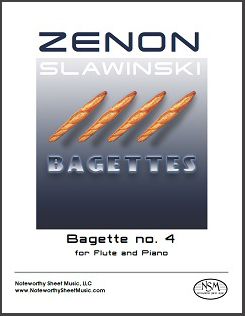 Bagette no. 4, by Zenon Slawinski
Bagette no. 4, by Zenon SlawinskiContemporary Composition for Flute and Piano
Flute Part and Piano Score, PDF $16.99
Zenon Slawinski studied music theory and composition at the University of Michigan with Leslie Bassett, William Bolcom, and William Albright. He also studied Campanology with Hudson Ladd. After graduating with honors he pursued a career in both music and graphic design. Mr. Slawinski was co-music director for the Peabody and Ohio State award winning Children's Radio Theatre program, and scored numerous independent and industrial films and films for the Smithsonian Institution that aired at Smithsonian museums and on PBS. He wrote the music to the popular political talk show The John McLaughlin Group. Mr. Slawinski was a founding partner of a multimedia production company and recording studio working in the early interactive days on educational and entertainment music projects in the CDi and CD-ROM formats, many of which won numerous awards. For more details of Zenon Slawinski's biography, please see the Composers section of the NSM website.
Bagette no. 4 is from a set of four Bagettes written by Zenon Slawinski for his flutist wife, for the two of them to play together. The piece showcases the flute and has challenging moments for both players throughout. The spelling of "bagette" is intentional. The piece opens and closes with a quick ostinato in ¾ in the piano part that lays the foundation for the feel of the entire Bagette. The second section is more pensive and contemplative, with the piano taking the lead initially. The next section is bold and in a new key - B major - and here the flute and piano engage in a playful interaction. The composer intends for the players to put their own spin on the piece and interpret the music freely.
You may also listen to audio of the piece, recorded on the composer's Yamaha MOTIF ES with the sampled piano and flute sounds found in the instrument. Click to listen
Customers who purchase the sheet music to Bagette no. 4 are entitled to a free rehearsal mp3 of the piano track with which the flutist can play along.
Piano score, 15 pages; Flute part, 7 pages; Total, 26 pages.
Preview
-
Elgar - Chanson de Matin - Fl & Pf
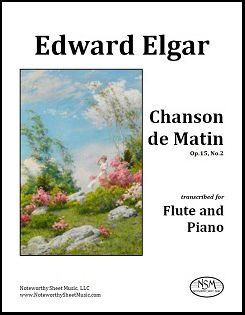 Chanson de Matin, Op.15, No.2, by Edward Elgar
Chanson de Matin, Op.15, No.2, by Edward ElgarTranscribed for Flute and Piano by C.A.Vater
Flute Part and Piano Score, PDF $6.99
Edward Elgar composed his Chanson de Matin for violin and piano c.1889-1890. The two companion pieces, Chanson de Matin (No. 2) and Chanson de Nuit (No. 1), together constitute his Op.15, and both pieces were later arranged for small orchestra by the composer. Chanson de Matin was received with great enthusiasm, and its initial and lasting popularity can be attributed largely to its strong melodic appeal. Enduring public affection for the piece has spawned the creation of numerous arrangements and transcriptions, including renditions for cello and piano, viola and piano, flute and guitar, piano solo, organ solo, and string quartet. Noteworthy Sheet Music offers two of our own transcriptions of the lovely Chanson de Matin, one for alto flute and piano and one for concert flute and piano.
Flute part, 2 pages; Piano Score, 4 pages; Total, 12 pages.
Preview -
Robichaux - Recurrence - Flute & Piano
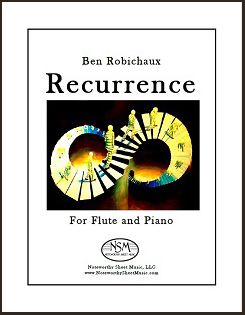 Recurrence, by Ben Robichaux
Recurrence, by Ben RobichauxContemporary Composition for Flute and Piano
Flute Part and Piano Score, PDF $12.99
NSM welcomed composer Ben Robichaux as a new contributor to our catalog in early June, 2017, when we published his piece Recurrence for flute and piano. For details of Mr. Robichaux's background, interests, and other works, please click the link to access the Composers section of the NSM website.
Recurrence was written for the composer's friend Michael Lyons. As outlined in the program notes, the "duet is framed in a traditional rondo form: ABACA. The returns of the A theme are never literal returns and repeated materials among the differing sections are never identical repetitions. These returns of A are the inspiration for the title, and the re-occurrence of the A material is a study on the lengths that a theme can be stretched and still be recognizable. The returns undergo extensive development. The B and C sections are meant to be extreme contrasts to the A sections as a means of cleansing the aural palate in order to erase the listener's memory of the theme. Despite the great lengths taken to blur the primary theme, its recognizability is undeniable. The closing section is a reflection on the basic differences among the three occurrences of the main theme. This final section is a summation of the processes that have previously been blurred by the contrasting sections of the piece. Ultimately the form portrays a futile fight that concludes with a peaceful resignation to the inevitable."
 The premiere of Recurrence took place in July, 2017, with Kenneth Cox (flute) and Bronwyn Schuman (piano). The performance was recorded by audio engineer Charles Hagaman; a sample can be heard by clicking the mp3 icon.
The premiere of Recurrence took place in July, 2017, with Kenneth Cox (flute) and Bronwyn Schuman (piano). The performance was recorded by audio engineer Charles Hagaman; a sample can be heard by clicking the mp3 icon. The cover artwork for our publication was created by Scoop Brancisco, used with permission.
Piano score, 10 pages; Flute part, 3 pages; Total, 15 pages.
Preview